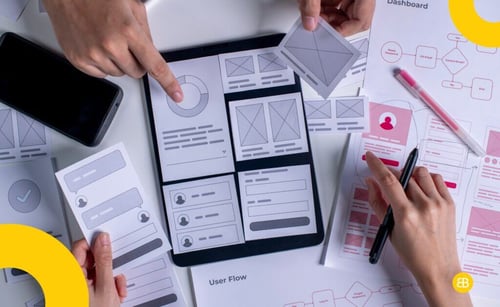Table of Contents
When you create products for consumers, knowledge is power. No one can help you understand the user better than the user themselves. That is why research methods are crucial in the UX design process.
UX research methods are essential tools that help designers and businesses create user-centric products that stand out. This article explores various UX research techniques, highlighting their benefits and how they can transform your design process.
Whether you are a UX designer looking to refine your approach, or a user wondering why companies set out to collect data from you, this article is for you. Let’s break down the most commonly used quantitative and qualitative UX research methods.
What is Quantitative Research in UX Design?

Quantitative user research is all about gathering and evaluating quantifiable numerical data from different forms of user testing. It aims to collect objective, measurable data on a population of users using high sample sizes.
The primary objective of user research methods is to indirectly assess the product’s usability after it has been finished or delivered. The return on investment (ROI) of a business or how a product stacks up against the competition are two other common applications of quantitative research.
When to Use Quantitative user research
Quantitative user research is most effective when conducted on an existing product or during the final stages of design. It is typically used at the beginning or end of the design cycle. To effectively time this research, it’s crucial to understand your research goals and the benefits it can bring to your designs.
Benefits of Quantitative Research
- Reduced Bias: Structured and controlled environments minimize human bias.
- Quantifiable Usability: Assigns numerical values to product usability, which can be persuasive for investors and stakeholders.
- Data Visualisation: Results can be easily presented in graphs and charts.
- Impact Measurement: Helps determine if design changes lead to statistically significant outcomes.
- Remote Conducting: Requires less direct contact with users and can be done remotely.
Potential Downsides
- Surface-Level Insights: Only indicates what is happening, not why.
- Lack of Anecdotal Data: Doesn’t provide direct user quotes or stories, which can also be valuable.
- Large Sample Size: Requires many participants for statistical significance, which can be challenging and costly.
- Redesign Clarity: Indicates the need for a redesign, but not how to implement it.
Types of Quantitative Research

Depending on what you want to learn about your product, there is a quantitative user research method for everything.
- Analytics
One of the best places to find quantitative data on your users is in analytics, particularly Google Analytics.
Analytics provide a transparent picture of a site’s usability and user behavior through measures like click-throughs, conversion rates, page views, and bounce rates. It can provide quantifiable data that suggests which areas of a site need improvement or if a full redesign is necessary.
- Benchmarking
The purpose of benchmark usability testing is to find ways to enhance a product or process by comparing it to what is considered standard or best in the industry.
It aids businesses in assessing their competitive situation, establishing objectives, and implementing improvement initiatives.
By comparing results against those of top performers on a regular basis, progress and innovation are encouraged.
- Heatmaps
Mouse heatmaps, like analytics, provide a very clear image of how a user interacts with a website. A mouse heatmap is a visual representation of a user’s actions on a website, including hovering, scrolling, clicking, and pausing.
Mouse heatmaps, which use radar-like color coding, reveal the areas that users are most interested in and can be used to increase conversion rates.
- Funnel Analysis
You can see the stages your users need to take to finish a task and evaluate their success at each one with the help of funnel analysis. To see what proportion of users are completing the task to the end, the map usually has a funnel shape.
With the use of a funnel analysis, you can see exactly where parts of the funnel are losing customers and where you can make improvements to increase conversions.
- A/B Testing
A/B testing compares design iterations with users to identify the superior version. Ideally, designs should differ by one or two key elements to ensure observed differences are accurate. While in-person testing can provide qualitative data, the percentage of users preferring each design clearly indicates the more effective version.
- Cohorts
A cohort analysis can be useful in examining user engagement over time. The enormous volume of new users tends to obscure the actions of your more seasoned customers.
To better determine whether engagement is growing over time or if it is just an illusion caused by expansion, a cohort analysis divides your users into related groups instead of bundling them all into one category.
Additionally, it will highlight the locations where users are leaving and suggest improvements to boost user retention.
What is Qualitative Research in UX Design?

To better understand user behaviours, motives, and experiences, qualitative research in UX design collects non-numerical data. Methods like focus groups, observations, and interviews are utilized. To make better design decisions and make products that are more user-centred and intuitive, this research explores user preferences and demands.
When to Use Qualitative Research
Because of its formative and summative nature, qualitative user research may be used to examine the efficacy of a final design as well as to guide design choices made throughout the product’s creation.
For this reason, qualitative user research is commonly carried out throughout the design process, including during redesign and after the product is complete.
Types of Qualitative Research
Numerous qualitative user research methodologies can bring valuable insight.
- Observations
In user observations, researchers observe a participant as they carry out a set of actions to gain a first-hand understanding of the product or service’s interaction with the user, any issues they may face, and the benefits they derive.
The reliability of participant observation is typically higher when it takes place in a natural environment as opposed to in the lab since this is where real users interact with the product.
- User Interviews
To better understand the goals, requirements, and actions of users, it is helpful to conduct user interviews and compile the resulting qualitative data.
In order to obtain thorough information, it’s important to ask open-ended questions. User interviews are a typical tool for user experience researchers and designers to gather insights about user behaviour and problems.
- Diary Studies
Researchers in diary studies have participants record their thoughts and actions on a product’s usability for a set amount of time.
Users document their actions, the times they execute them, and the emotions they experience as a result of using a product.
Patterns in user demands and emotions, along with any usability issues or other sources of discomfort, can be revealed by diary studies when conducted over an extended period of time.
- Focus Groups
Similar to one-on-one interviews, focus groups allow for the simultaneous participation of numerous consumers. These work wonderfully for collecting several user perspectives on a large amount of qualitative data concurrently.
Since participants may feel more comfortable expressing themselves in the presence of other test subjects, these sessions are likely to have a more conversational and creative vibe.
The Mixed-Method Approach

The mixed-method approach in UX research combines qualitative and quantitative methods to provide a comprehensive understanding of user experiences.
By integrating numerical data from surveys or A/B tests with in-depth insights from interviews or observations, researchers can validate findings and uncover nuanced user behaviors and motivations. This approach ensures more robust and actionable design decisions, addressing both the “what” and the “why” of user interactions.
Frequently Asked Questions
What is the Difference Between UX and UI?
Why is UX Design Research Important?
Final Thought

User experience research methods help UX designers understand the strengths and weaknesses of their products. This allows for informed decisions, leading to innovation and progress. Not only can designers optimize their work more easily, but consumers also get to enjoy a product tailored to their needs.
To discover how EB Pearls can help you leverage UX research methods for creating exceptional digital experiences, contact us today.

Michael leads the UX/UI team at EB Pearls, bringing 30+ years of experience in interaction design and crafting digital products for Fortune 50 companies.
Read more Articles by this Author
